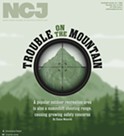Wednesday, April 6, 2016
Feds, States Ink Historic Klamath Agreements
Posted By Thadeus Greenson @ThadeusGreenson on Wed, Apr 6, 2016 at 4:48 PM
Under a cloudless blue sky and with the water of the Klamath River glistening in the sun behind them, a host of federal, state and tribal officials gathered around a fish cleaning table this morning to sign a pair of agreements to remove four dams and chart a new path forward for communities from the river’s mouth to its headwaters.
The signing ceremony — which drew two governors, a presidential cabinet member, a congressman and a handful of tribal leaders — finalized a revised agreement to remove the four hydroelectric dams that clog the lower Klamath River. And the ceremony came just months after the original Klamath agreements — three separate pacts between basin stakeholders to remove the dams, manage water, provide economic stability and restore the watershed — were torpedoed by congressional inaction.
“This is the absolute essence of non-extremism and non-polarization,” Gov. Jerry Brown said, praising the work of the diverse group of stakeholders that put differences aside to find common ground and compromise. “It’s called working together the way the American government should.”
The two pacts signed this morning are a revised Klamath Hydroelectric Settlement Agreement (KHSA) and a new Klamath Power and Facilities Agreement (KPFA). The KHSA provides that the states of Oregon and California will form a joint nonprofit corporation to take over ownership of the dams from PacifiCorp and oversee the dams' decommissioning and removal. The KPFA, meanwhile, takes steps to protect upper basin water and land users from potential regulatory and legal threats associated with reintroducing — through the dam removals — salmon and other species that for decades have been absent in the upper river.
It appears the KPFA is largely a show of good faith to stakeholders in the upper basin as one part of the original agreements — dam removal — is moving forward while others — like water and energy security for irrigators, habitat restoration projects and economic security for the Klamath Tribes of Oregon — are not.
Oregon Gov. Kate Brown said today marks the beginning of a new chapter on the Klamath, but much work remains, including honoring the hard-fought compromises that went into the original agreements and providing water and energy security to the farmers and ranchers of the upper basin, who depend on the river for their livelihoods.
“I will not rest until we start that second chapter,” she said.
While parties on all sides of the Klamath seemed ready to retreat to their corners and retrench into their philosophical divides after the agreement’s deadline passed without action from Congress late last year, those present this morning struck a much different tone. Scott White, executive director of the Klamath Water Users Association, said there has been some concern that the newly restructured KHSA would leave some stakeholders behind. But, he said, he’s encouraged that the relationships and commitments forged over the course of a decade are holding strong.
“Our future will be determined by what happens next,” said White, whose organization represents a group of irrigators who work the old wetlands and lakes that the federal government turned into farmlands under the Klamath Project of the early 1900s. “It would have been very easy to make this all about the dams, but none of you did that.”
In her comments, U.S. Department of the Interior Secretary Sally Jewell said that’s really at the heart of what might become the largest river restoration project in the history of the United States — recognizing and respecting the people and communities that depend on the river, from its headwaters to its mouth. She said this is a huge first step toward laying a “road map to long-term restoration and sustainability for all.”
The signing ceremony opened with a Yurok prayer, and speakers addressed the crowd flanked by four young Yurok women who, clad in traditional regalia, stood sentry over the proceedings. Yurok Tribal Vice Chair David Gensaw Sr. said the cultural significance of the Klamath River and its salmon runs is massive.
“Our ancestors told us Yurok people to take care of the salmon, because once the salmon are gone, so are the Yurok people. We don’t plan to go anywhere,” he said, adding that the dams, which block off hundreds of miles of salmon spawning habitat and clog flows, warming the river’s water and causing toxic algae flows, are a threat to the tribe’s culture, subsistence and economy.
North Coast Congressman Jared Huffman told the crowd that he couldn’t help but notice, while other speakers were addressing the crowd and opining on the historic day, sea lions barking in the distance, an osprey fishing in the river’s mouth and even a golden eagle perched in a nearby tree. As much damage as has been done, he said, “the ecological heart of this river is still very much alive. The soul of this river is very much alive.”
Huffman and other speakers noted the agreements make it now possible to bring the river back to its full health and repair some of the damage — and the injustices — that have been done.
Don Gentry, chair of the Klamath Tribes of Oregon, said there’s no question that it was “a really good day.” Seeming to hold back tears at times, Gentry explained that much is still uncertain for the tribes he represents near the river’s headwaters, but he said he believes parties can work together to continue to find a path forward.
“We look at this as one positive step forward, a positive step toward justice, a positive step toward restoration, a positive step toward restitution,” he said.
For his part, Jerry Brown said restoration of the 255-mile Klamath River — dammed decades ago and its communities divided over competing interests — could send a powerful message, not just to the nation but to the world.
“This is a good exercise of humankind, correcting some of the mistakes it has made in the past,” he said.
For more on the history of the Klamath agreements, see prior Journal coverage here.
The signing ceremony — which drew two governors, a presidential cabinet member, a congressman and a handful of tribal leaders — finalized a revised agreement to remove the four hydroelectric dams that clog the lower Klamath River. And the ceremony came just months after the original Klamath agreements — three separate pacts between basin stakeholders to remove the dams, manage water, provide economic stability and restore the watershed — were torpedoed by congressional inaction.
“This is the absolute essence of non-extremism and non-polarization,” Gov. Jerry Brown said, praising the work of the diverse group of stakeholders that put differences aside to find common ground and compromise. “It’s called working together the way the American government should.”
The two pacts signed this morning are a revised Klamath Hydroelectric Settlement Agreement (KHSA) and a new Klamath Power and Facilities Agreement (KPFA). The KHSA provides that the states of Oregon and California will form a joint nonprofit corporation to take over ownership of the dams from PacifiCorp and oversee the dams' decommissioning and removal. The KPFA, meanwhile, takes steps to protect upper basin water and land users from potential regulatory and legal threats associated with reintroducing — through the dam removals — salmon and other species that for decades have been absent in the upper river.
It appears the KPFA is largely a show of good faith to stakeholders in the upper basin as one part of the original agreements — dam removal — is moving forward while others — like water and energy security for irrigators, habitat restoration projects and economic security for the Klamath Tribes of Oregon — are not.
Oregon Gov. Kate Brown said today marks the beginning of a new chapter on the Klamath, but much work remains, including honoring the hard-fought compromises that went into the original agreements and providing water and energy security to the farmers and ranchers of the upper basin, who depend on the river for their livelihoods.
“I will not rest until we start that second chapter,” she said.
While parties on all sides of the Klamath seemed ready to retreat to their corners and retrench into their philosophical divides after the agreement’s deadline passed without action from Congress late last year, those present this morning struck a much different tone. Scott White, executive director of the Klamath Water Users Association, said there has been some concern that the newly restructured KHSA would leave some stakeholders behind. But, he said, he’s encouraged that the relationships and commitments forged over the course of a decade are holding strong.
“Our future will be determined by what happens next,” said White, whose organization represents a group of irrigators who work the old wetlands and lakes that the federal government turned into farmlands under the Klamath Project of the early 1900s. “It would have been very easy to make this all about the dams, but none of you did that.”
In her comments, U.S. Department of the Interior Secretary Sally Jewell said that’s really at the heart of what might become the largest river restoration project in the history of the United States — recognizing and respecting the people and communities that depend on the river, from its headwaters to its mouth. She said this is a huge first step toward laying a “road map to long-term restoration and sustainability for all.”
The signing ceremony opened with a Yurok prayer, and speakers addressed the crowd flanked by four young Yurok women who, clad in traditional regalia, stood sentry over the proceedings. Yurok Tribal Vice Chair David Gensaw Sr. said the cultural significance of the Klamath River and its salmon runs is massive.
“Our ancestors told us Yurok people to take care of the salmon, because once the salmon are gone, so are the Yurok people. We don’t plan to go anywhere,” he said, adding that the dams, which block off hundreds of miles of salmon spawning habitat and clog flows, warming the river’s water and causing toxic algae flows, are a threat to the tribe’s culture, subsistence and economy.
North Coast Congressman Jared Huffman told the crowd that he couldn’t help but notice, while other speakers were addressing the crowd and opining on the historic day, sea lions barking in the distance, an osprey fishing in the river’s mouth and even a golden eagle perched in a nearby tree. As much damage as has been done, he said, “the ecological heart of this river is still very much alive. The soul of this river is very much alive.”
Huffman and other speakers noted the agreements make it now possible to bring the river back to its full health and repair some of the damage — and the injustices — that have been done.
Don Gentry, chair of the Klamath Tribes of Oregon, said there’s no question that it was “a really good day.” Seeming to hold back tears at times, Gentry explained that much is still uncertain for the tribes he represents near the river’s headwaters, but he said he believes parties can work together to continue to find a path forward.
“We look at this as one positive step forward, a positive step toward justice, a positive step toward restoration, a positive step toward restitution,” he said.
For his part, Jerry Brown said restoration of the 255-mile Klamath River — dammed decades ago and its communities divided over competing interests — could send a powerful message, not just to the nation but to the world.
“This is a good exercise of humankind, correcting some of the mistakes it has made in the past,” he said.
For more on the history of the Klamath agreements, see prior Journal coverage here.
Speaking of...
Readers also liked…
more from the author
-
Seeking Salvation
'Living in amends,' a candidate for resentencing hopes for another chance
- Apr 18, 2024
-
UPDATE: Artillery Shell Deemed Safe in Ferndale
- Apr 12, 2024
-
Turning the Titanic
Cal Poly Humboldt recognized for leadership in addressing global plastics crisis
- Apr 11, 2024
- More »






































